Original images held by the Harvard-Yenching Library of the Harvard College Library, Harvard University
Summary written by Jeonghun Choi (Ph.D. Candidate, Dept. of East Asian Languages and Civilizations, Harvard University)
This archive consists of forty-two documents previously owned by the Ōsaki Shiseidō 大崎至誠堂 (or Ōsaki shoten 大崎書店) – a bookstore, lending library, and printing office located in Kokufu Village 国府村, Oku District 邑久郡, Okayama Prefecture. This rich archive offers multiple pieces of evidence through which we can reconstruct Okayama’s media ecology in the 1880s and 1890s.
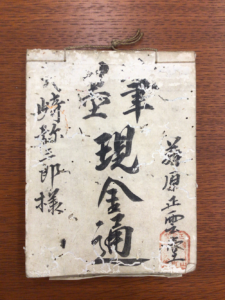
A collection that preserves the invoices issued by Fujiwara Hisanobu’s Seiundō.

The seal of Seiundō left in one of the invoices (“筆墨現金通” [1894-1895]).
No trader exists in isolation. Some documents show Ōsaki Shiseidō’s reliance on other local sellers. The archive includes invoices issued by Yoshida Sakushichi’s 吉田朔七 Yoshida shobō 吉田書房, Fujiwara Hisanobu’s 藤原久信 Seiundō 正雲堂, bookseller Takeuchi Yosaburō 武内彌三郎, and Ōkubo’s bookstore大久保. All these dealers had their shops in Okayama (“明治廿七年四月起 図書御通 大崎様” [1894], “藤原正雲堂 筆墨現金通 大崎彌三郎様” [1894-1895], “明治廿八年三月 書籍御通 大崎彌三郎様” [1895-1896], and “明治廿八年 書籍御通 四月より” [1895]).
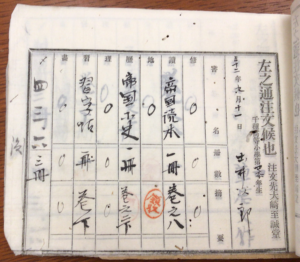
A book order from Doi Jirō 土井次郎, a fourth-year student from Chigusa Higher Elementary School, on September 11, 1899. He ordered a copy of Imperial Reader 帝国読本, a copy of A Short History of the Japanese Empire 帝国小史, and a copy of a calligraphy textbook (Shūjijō 習字帖) (“千種四年” [1899]).
Furthermore, Ōsaki was capable of producing goods on its own. In 1896, the shop had to use an attendance record notebook as its template to register the lending records (“明治二十九年六月 大崎書店 各号貸本名細録”). In September 1898, however, it established the Printing Office of Ōsaki shoten 大崎書店印刷部, starting its new business as a printing and binding shop (“明治三十一年九月起 調製手数料日録 大崎書店印刷部” [1898]). Afterwards, Ōsaki shoten used account books they printed by themselves.
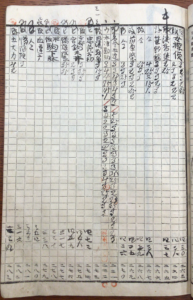
Shinkaitei Ryūgyoku’s 新開亭柳玉 Kizu Kansuke 木津勘助 was one of the most borrowed books from 1896 to 1897 (“明治二十九年六月 大崎書店 各号貸本名細録”).
The most intriguing aspect of the archive is the borrowing records that Ōsaki kept as a lending library. From a notebook that registers the book’s title, fee paid by the borrowers, and registration number, one immediately gets a sense of which titles were popular among the users, even though this particular document does not include any explicit information on the borrowers and their identities. Ōsaki had two copies of Sakurai Sanze’s 桜井三世 Tengu kozō Kiritarō no den 天狗小僧霧太郎之伝 (1891), for example, which were borrowed at least 52 times in total from June 1896 to around June 1897. Shinkaitei Ryūgyoku’s 新開亭柳玉 Kizu Kansuke 木津勘助 (1895) was borrowed 23 times in the same time span and then sold to a customer, as suggested by the stamped mark “Sold” (As other lending libraries did in the same period, Ōsaki shoten would sell some of the books for lending). In many lending libraries in the Meiji period, the week-long rental fee was about a tenth of the copy’s standard price. But Ōsaki’s fee was subject to change, and sometimes the borrowers had to pay more than ten percent. The rental fee for Yamada Bibyō’s 山田美砂 Ichigo hime いちご姫 (Kinkōdō, 1892) ranged from 3 to 5 sen, which is 12-20% of the standard price, 25 sen (“明治二十九年六月 大崎書店 各号貸本名細録”).
Some of the registers in this notebook confirm our prior knowledge vis-à-vis the popularity of some Meiji fictional works. Many customers borrowed Setchūbai 雪中梅 (1886) and Oshi no namida 唖の涙 (1894), political novels by Suehiro Tetchō 末広重恭 and Fukuchi Genichirō 福地源一郎 respectively. Other registers arouse interest in titles that are almost forgotten today. Among the popular titles were included the fifth Okinaya Sanba’s 五代目翁家さん馬 (Katsura Masakichi 桂正吉) Maigofuda 迷子札 (1890), Murai Gensai’s 村井弦斎 Asahi sakura 朝日桜 (1895), and Ichiryūsaibunsha’s 一立斎文車 Sanke sanyūshi 三家三勇士 (1898), which have now become rather obscure among researchers, even if undeservedly so.
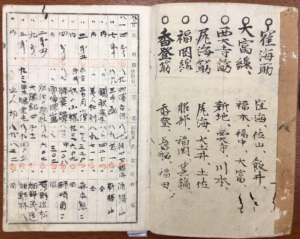
The section titles and the register pattern in the document After July of 1897 suggest that Ōsaki was a traveling library (“三拾年七月以降” [1897]).
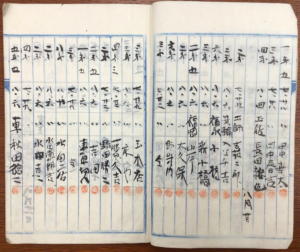
An account book that registers paid rental fees from July 1897 to February 1898 (“明治三十年七月 貸本見料受領帳” [1897-1898]).
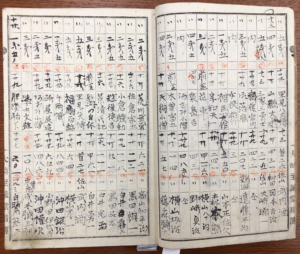
The books that readers of Sayama borrowed in October 1897 include Kyokutei Bakin’s 曲亭馬琴 Satomi Hakkenden 里見八犬伝 (1814-1842) and Fukuzawa Yukichi’s 福沢諭吉 Fukuō hyakuwa 福翁百話 (1897) (“三拾年七月以降” [1897]).
